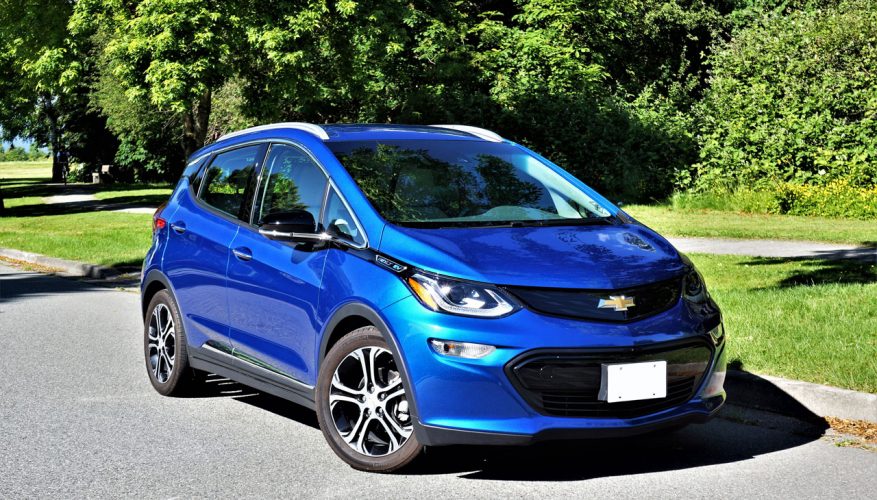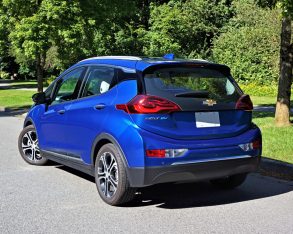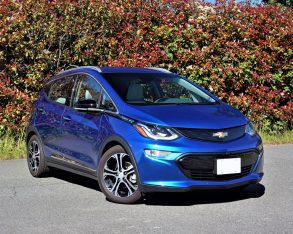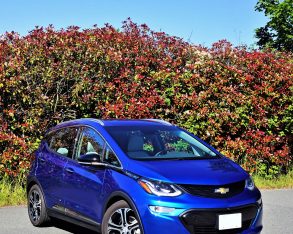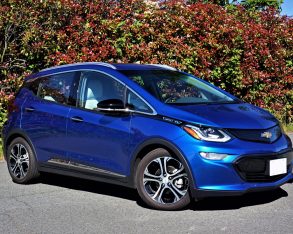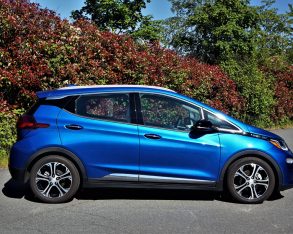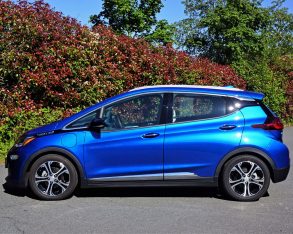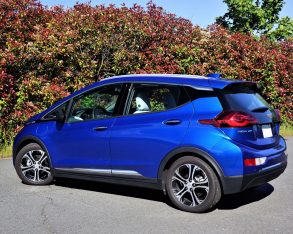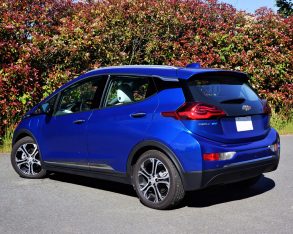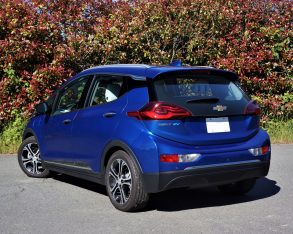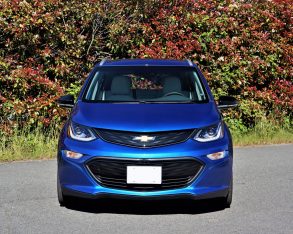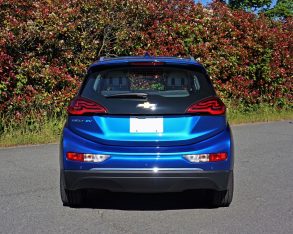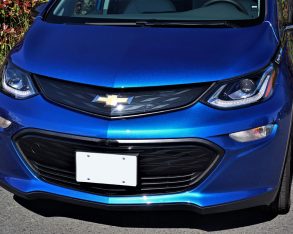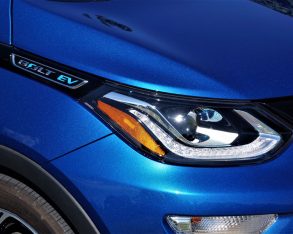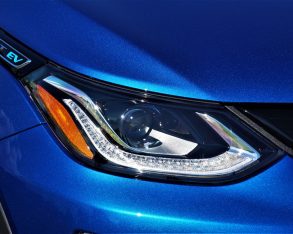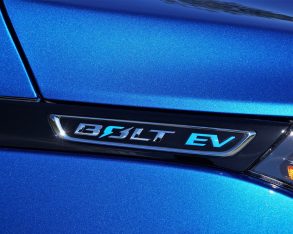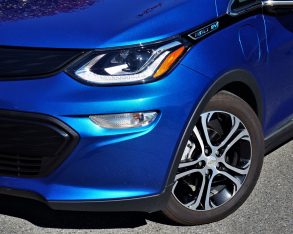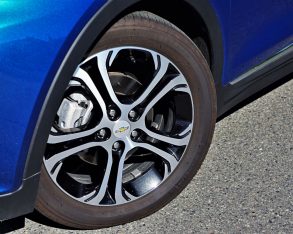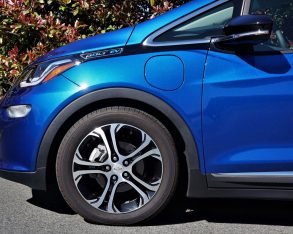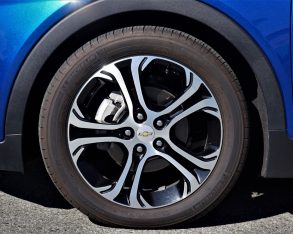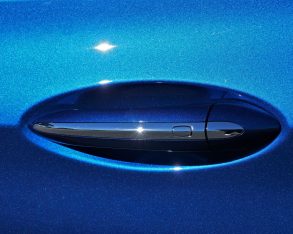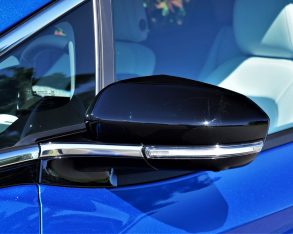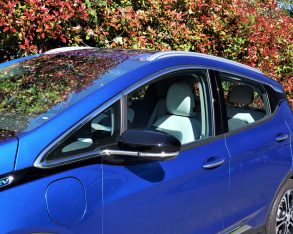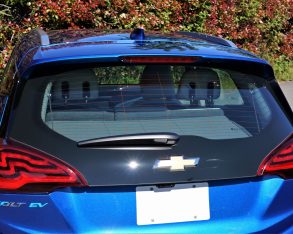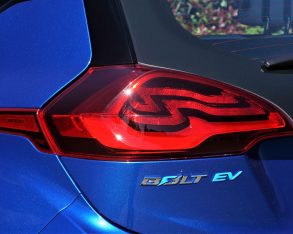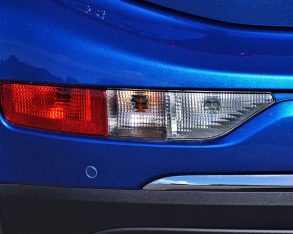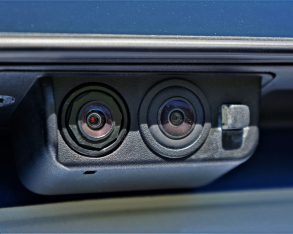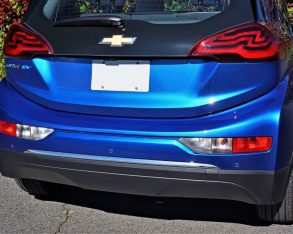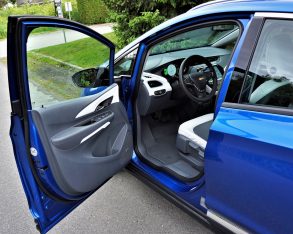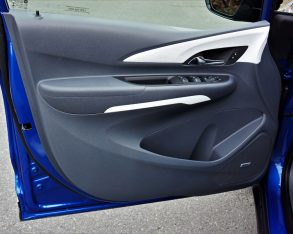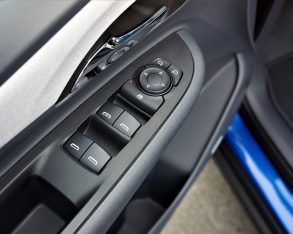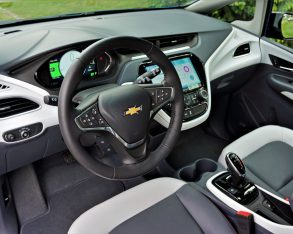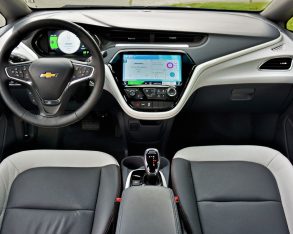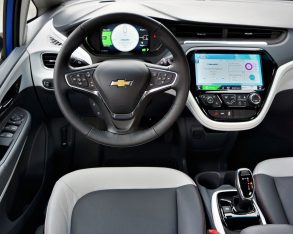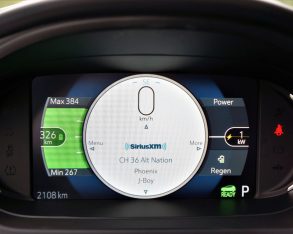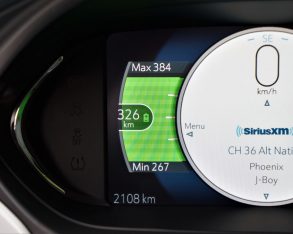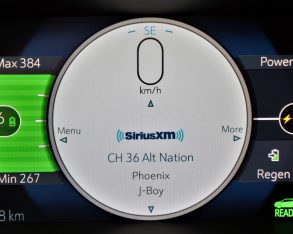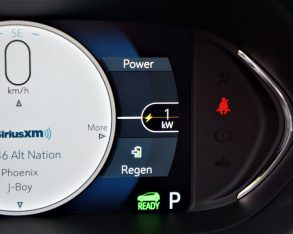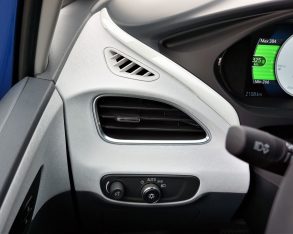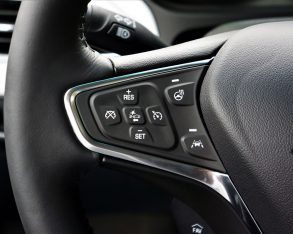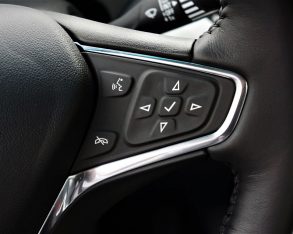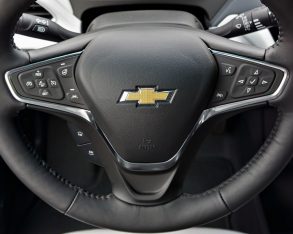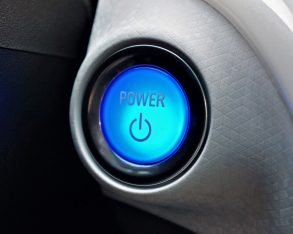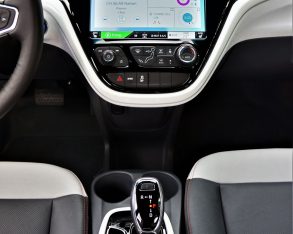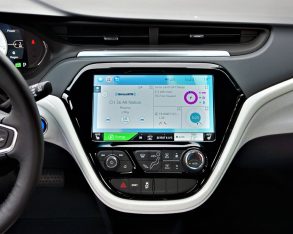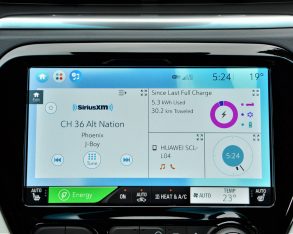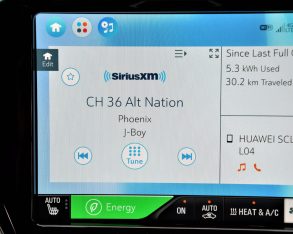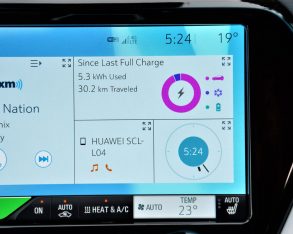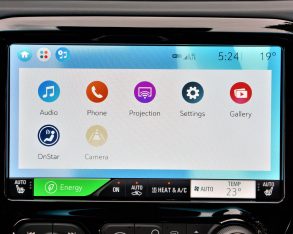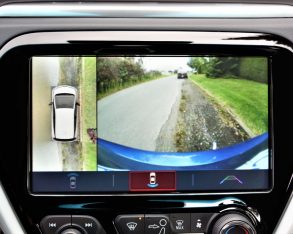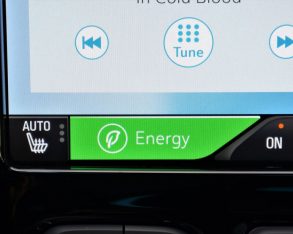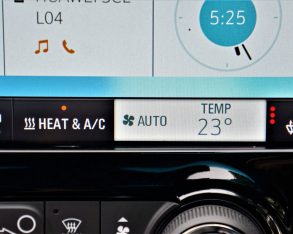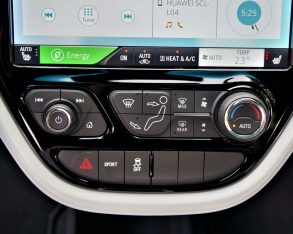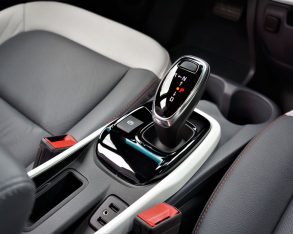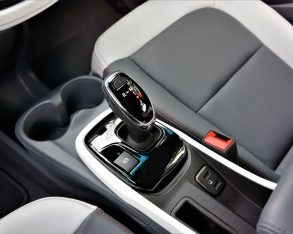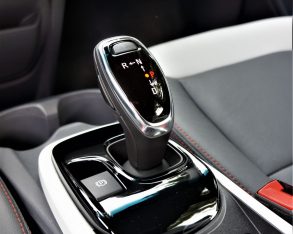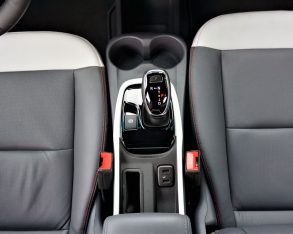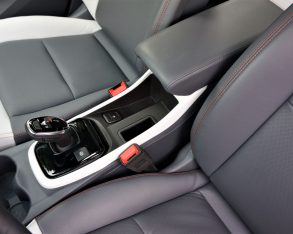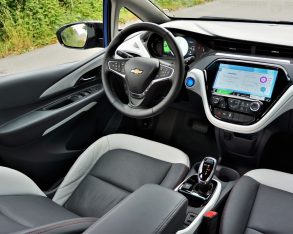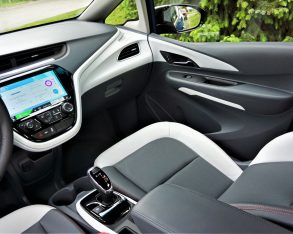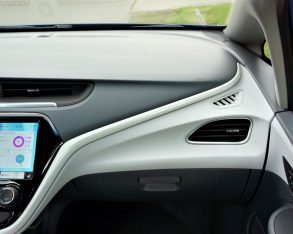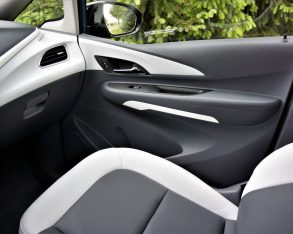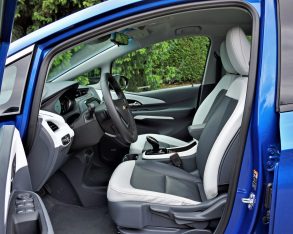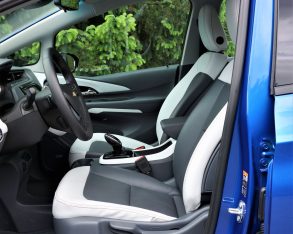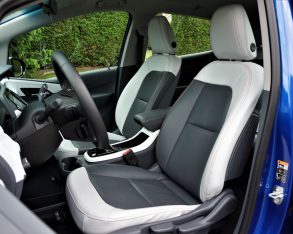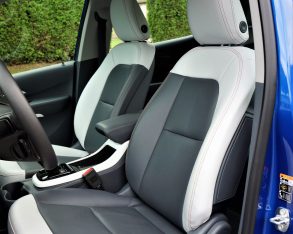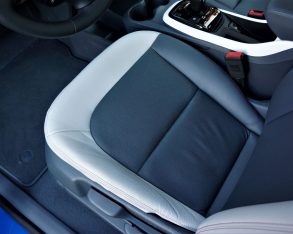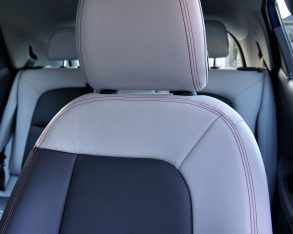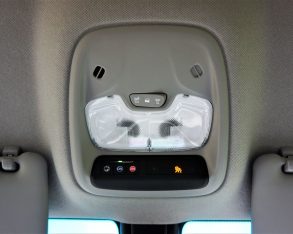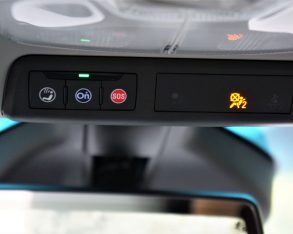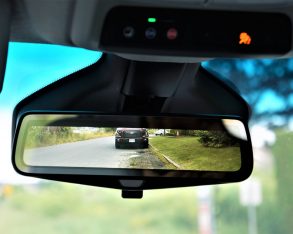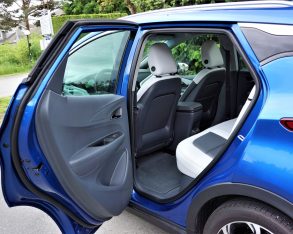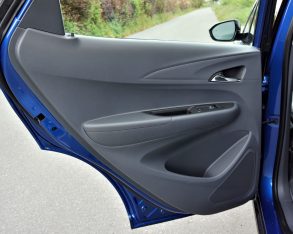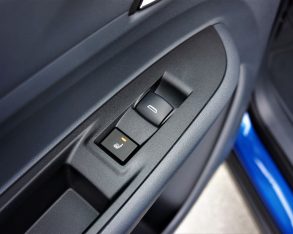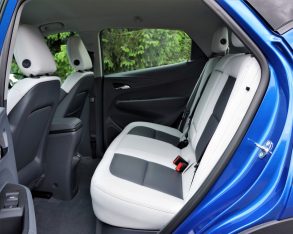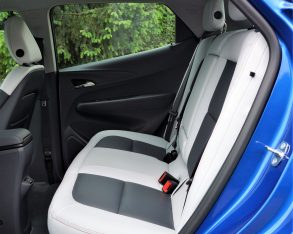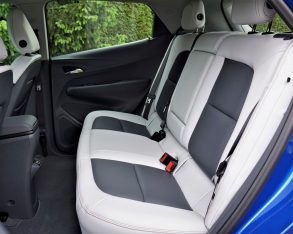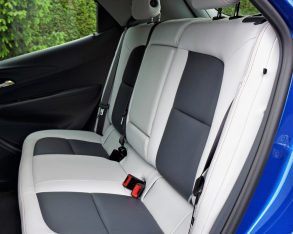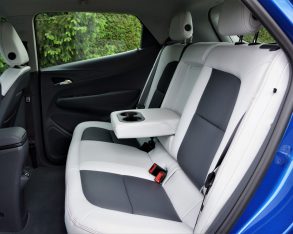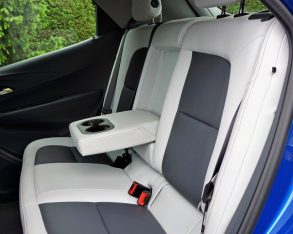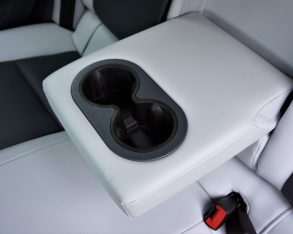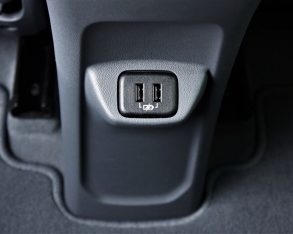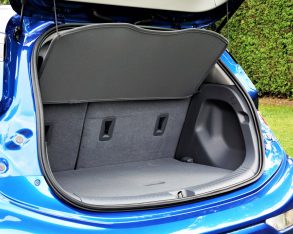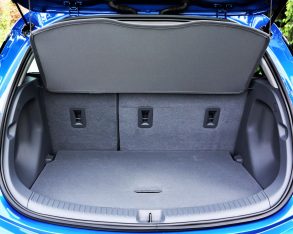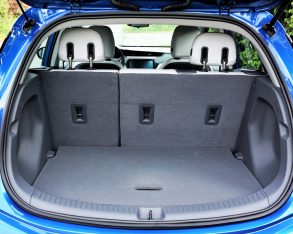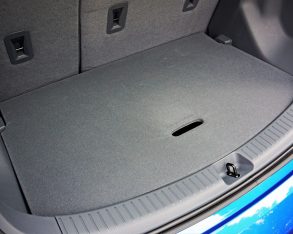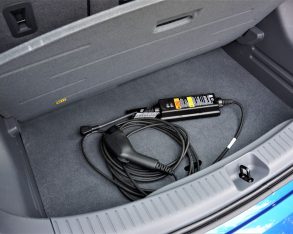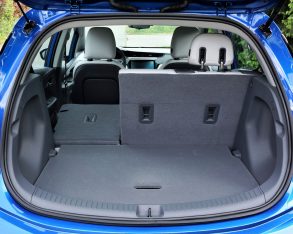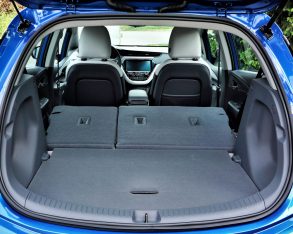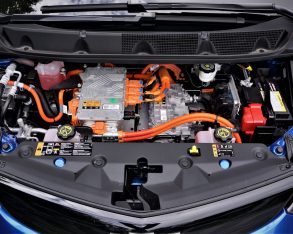Surprised that Chevrolet’s new Bolt EV is the best-selling electric vehicle in Canada? It actually hit number one before 2017’s
 |
| The Bolt mixes subcompact hatchback styling with some crossover details, but under the skin its 100-percent EV. (Photo: Karen Tuggay, Canadian Auto Press) |
halfway point, and for good reason.
Tons of advertising! Sorry, I couldn’t resist that. While partially true the umpteen millions Chevy has spent promoting its newest EV is hardly the main reason it’s succeeding. More importantly, the Bolt fully lives up to all the hype being lauded upon it by the bowtie brand itself, industry pundits like me, and now customers aplenty.
How many customers? At the close of November it had accumulated 1,292 paid followers in Canada, and while Tesla Model 3 buyers might scoff at such a puny figure, it’s exactly 1,292 more deliveries than Tesla’s Model 3 over the same 11 months.
One
 |
| Tall hatchback design combines great visibility with excellent functionality. (Photo: Karen Tuggay, Canadian Auto Press) |
thing the Bolt has common with the Model 3? Both automakers could’ve sold many more if more cars were available (or any in the case of Tesla), a local GM dealer (that still had a Spark EV in the showroom last time I dropped by) quite adamant that they’d been forced to turn plenty of would-be buyers away for lack of product.
After spending a week with this subcompact hatchback, I attest those late to the party are missing out. While it probably won’t replace Fiat’s 500 Abarth and Ford’s Fiesta ST as favoured hooning subcompact five-doors in my life, the Bolt is brilliant fun to drive fast and most definitely up to the task. What’s more, I’ve never been less concerned about running out of power, no matter how recklessly wasteful I was with the power grid.
Go
 |
| The Bolt’s rear styling incorporates a floating C-pillar, not unlike the competitive BMW i3. (Photo: Karen Tuggay, Canadian Auto Press) |
ahead and gripe in the comments section below, but the Bolt’s electric motor didn’t get on the esteemed WardsAuto’s Top Ten Engines List for 2018 because it’s boring. Along with internal combustion engines we already love, such as Jaguar’s new 2.0-litre turbo four (XF, etc), Hyundai group’s new 3.3-litre turbo V6 (Genesis and Kia Stinger), Ford’s new 2.7-litre twin-turbo V6 and 5.0-litre V8, Infiniti’s 3.0-litre turbo V6, and (drumroll please) the sensational 2.0-litre turbo four found in the equally brilliant Honda Civic Type R, the Bolt’s 150-kW pure electric propulsion system is joined by Toyota’s 2.5-litre Atkinson-cycle bulletproof workhorse four-cylinder hybrid power unit, the 3.6-litre Pentastar V6 plug-in from the Chrysler Pacifica Hybrid, and the innovative 130-kW fuel cell/electric power unit from Honda’s new Clarity. To get on this list is an impressive feat, and a first for a pure electric motor in the annual program’s 24 years.
This
 |
| While the Bolt’s overall five-door hatchback shape doesn’t break any design rules, many of its details are quite creative. (Photo: Karen Tuggay, Canadian Auto Press) |
type of success is nothing new for the resurrected General Motors. In fact, one of the reasons GM’s stock price has risen over the past month, year, and five-year intervals, and Ford’s has been on the decline for all of the above (except the five-year), is its success in the plug-in arena, first with the Volt, the number one selling PHEV period, and now the Bolt, which could very well zip into the top North American sales spot once availability matches demand.
And no, I’m not about to continue digressing (too far) into upcoming Model 3 chatter despite presales humbling any current or past EV, because it’s not yet available in Canada and may not be for some time (Tesla was initially targeting the end of 2018, but wiser 3 waiters aren’t expecting it until sometime in 2019 or perhaps longer).
 |
| That’s some bold badging, Chevy obviously wanting to make sure passersby know you’re driving an electric. (Photo: Karen Tuggay, Canadian Auto Press) |
Of course, most of us are hoping the car and Tesla will succeed, as the auto sector newcomer is a modern-day success story that’s truly shaken the old guard to its knees (especially on the ever-escalating Fed-induced equity markets where real-world results haven’t been as important as “fingers crossed” projections in recent years), so we’ll cross that bridge (hopefully while driving a Model 3) when we come to it.
The Bolt EV is in the here and now (or at least it was before 2017 models sold out), and can be had for $43,095 before freight and dealer fees, discounts (good luck with that), and government rebates (up to $5,000 in BC, $14,000 in Ontario, and $8,000 in Quebec).
 |
| Some nice sporty elements make the Bolt stand out. (Photo: Karen Tuggay, Canadian Auto Press) |
I know that price is mighty close to BMW’s i3, but despite the Bimmer’s near F1-tech levels of carbon-fibre construction, better handling, mostly nicer finishings inside, and that all-important blue and white roundel, it doesn’t even come close to the Bolt’s EV class when it comes to adrenaline inducing acceleration, driving quickly all day in wild abandon (in comparison to an EV’s usual range anxiety), or going as far as you possible can on a single charge.
Where the 2017 i3 has been boosted to an impressive 200-km range (183-km as per the EPA) thanks to a new 33.0-kWh lithium-ion battery (which is 10.0-kWh more than the previous one), the Bolt uses a much more convincing 60-kWh lithium-ion battery for a claimed range of 383 km! That’s right, almost twice the range of the i3. There’s no gasoline-powered range extender (REx) engine, but with the ability to cover such distances on a single charge does anyone really need the added weight and complexity of a tiny putt-putt motor? Hardly. The new 2018 Leaf, incidentally, can reportedly cover a conservative EPA estimate of 241 kilometers between charges, up from 172 km.
 |
| The Premier package adds unique machine-finished 17-inch alloys, replacing the standard painted 17-inch rims. (Photo: Karen Tuggay, Canadian Auto Press) |
Tesla Model S owners are giggling right about now, or at least those who spent upwards of $170k on a P100D that can manage up to 542 km after a full charge (even the base 75 is good for 426 km), but the Model S starts out at about twice the price of the Bolt and that aforementioned model quickly escalates to nearly $200,000 with options, so it’s just as silly as comparing the go-fast performance of a Porsche Panamera Turbo to Chevy’s subcompact Sonic.
Speaking of performance, the Bolt includes a Sport mode to liven up acceleration, and as I mentioned earlier you can drive it like a regular car without worrying about running out of juice. In fact, I raced around more in this Bolt than I would in most internal combustion engine-powered cars because I wasn’t concerned about fuel economy or tailpipe emissions.
 |
| Complex LED taillights are standard. (Photo: Karen Tuggay, Canadian Auto Press) |
When the Bolt came into my care it showed 373 kilometers on the estimated range indicator, while the odometer had ticked off 2,079 real km. After my first stint behind the wheel 21 km were added for a 2,100-km odo total, yet only 6 km of range had been used up with 367 km of potential distance remaining.
Realizing better than advertised range I picked up my pace and drove it like I stole it, running the range estimator down to 281 km after 41 actual km and a total of 2,141 km on the odo, which meant that even when driven hard the Bolt only managed to eat up 3 km of extra range potential than if I’d babied it. That’s not actually true, of course, because if I’d gone easier on the throttle it would’ve had even more remaining in its battery. The Bolt has a pretty sophisticated range estimation setup actually, at this point showing a possible max range of 331 km if I’d been willing to soften my driving style, or a minimum of 229 km if I kept up my teenage antics.
 |
| A two-tone interior spruces up the Premier cabin. (Photo: Karen Tuggay, Canadian Auto Press) |
It was hardly time for a charge, but I needed some photos of the Bolt plugged in (which I forgot to download from my smartphone and submit to the photo editing team) and simultaneously needed a few things from my local Walmart and therefore plugged in at 280 km of range, took a few photos, shopped for 15 minutes, and unplugged at 287 km of estimated range (or a max of 338 km, min of 234).
To wrap up the range experience, after mostly driving the Bolt all week (we had a compact SUV, pickup and minivan in the test fleet as well), I enjoyed my last 45 minutes blasting back to GM in Sport mode as usual, arriving with an estimated 273 km on the range indicator (max of 322 or min of 223) with a total of 2,163 km on the odo.
 |
| The Bolt’s cabin is attractively designed, but comes up short in premium-like soft surfaces. (Photo: Karen Tuggay, Canadian Auto Press) |
I’d say it only took 84 km to fall head over heals for the Bolt, but in actual fact it had me at hello. Not when first walking up to it, as its five-door hatchback design, complete with roof rails for a bit of crossover styling thrown in, is merely inoffensive to my style meter. Really, like the larger Volt there’s nothing particularly exciting about the design, but this can be said about most subcompact hatchbacks, other than the 500 Abarth (although it’s really a smaller city car) and Fiesta ST mentioned earlier, Hyundai’s new Accent, Kia’s Rio, and Chevy’s own Sonic that I happen to like a lot (a shame Chevy never puts these on the press fleet as it’s a great car that gets nowhere near the attention it deserves). I suppose that list of decent looking subcompacts is growing, but of course my opinion on styling is subjective so a moot point. If you like the Bolt’s design, more power to you. It’s merely ok with me.
 |
| The Bolt’s graphic interfaces are some of the industry’s best. (Photo: Karen Tuggay, Canadian Auto Press) |
Before flipping for its range and performance, the Bolt’s interior design and fabulous digital displays lured me in. Its two-tone light grey and black motif on the dash, door panels and seat upholstery made for a really nice look, improved upon with red stitching in key areas, plus tastefully applied brushed aluminum and chrome, and a bit more piano black lacquered plastic than I like. As with all GM products the switchgear was impressive, while the Bolt might have the automaker’s best fully configurable digital gauge cluster and infotainment touchscreen combination yet.
The former includes centre information on a nice white background, a darkened exterior and bold green highlights, with the usual driving and ancillary info on the white plus eco-related stuff on the green. Likewise, the massive 10.2-inch centre stack-mounted infotainment touchscreen includes beautifully detailed graphics in white, blue and green.
 |
| The primary gauge cluster is purely digital. (Photo: Karen Tuggay, Canadian Auto Press) |
It’s a full tablet-style connectivity pod, deep and rich with information and especially attractive in its layout and functionality, the latter including Android Auto and Apple CarPlay, a clear backup camera (with an bird’s-eye view option), available navigation, plus the usual audio, phone, car setup, etc. Just below, Chevy includes analogue controls for quick access to an excellent optional Bose audio system (and likely a decent enough six-speaker base stereo), a handy home screen button, and HVAC controls for the single-zone auto climate control system. It’s all organized sensibly with buttons large enough to use with winter gloves.
 |
| The 10.2-inch infotainment display is superb. (Photo: Karen Tuggay, Canadian Auto Press) |
Most other controls are surprisingly ordinary, including the array of steering wheel-mounted switchgear, which even includes an available heated rim, while the shift lever is an electronic type that just needs a quick tap to engage, not unlike others used by Mercedes, BMW (i3 aside), Dodge, etc. An electromechanical parking brake takes care of the Bolt when stationary, while just above on the instrument panel is a cool looking blue glowing ignition button.
Speaking of cool, way up high is an available auto-dimming rear camera mirror, this replacing the standard mirror in my tester. It provided excellent rear visibility, but takes a little bit of getting used to. Really, the view out the back is expansive, but you can’t tilt it up or down to see further, and vehicles behind appear closer than they really are. Then again, it converts back to a conventional mirror anytime you want, giving you the best of both worlds. On this note, the Bolt provides excellent inherent visibility due to a taller than average ride height and lots of window glass.
 |
| An overhead camera comes with Premier trim. (Photo: Karen Tuggay, Canadian Auto Press) |
Full disclosure, many of the high-end features in my tester came as part of top-line Premier trim, which was provided in place of a base LT. This meant the price increased by $5,000 to $48,095 due to those roof rails mentioned earlier, plus unique 17-inch Ultra-Bright machined alloys, turn signal indicators in the side mirror housings (that should be standard on a $43k vehicle), chrome detailing on the door handles, ambient interior lighting, the heatable leather-wrapped steering wheel, an innovative auto-dimming rear camera mirror, a 360-degree surround parking camera, heated front seats (hello GM, this is Canada and heated seats should be standard at this price), heatable rear seats, a flip-down rear centre armrest (again, why isn’t this standard?), a removable cargo floor with under-storage (starting to see a theme here?), rear parking sensors, blindspot monitoring with lane change alert and rear cross-traffic alert, and more.
 |
| Infotainment controls and a nicely organized single-zone auto HVAC interface sit below the central display. (Photo: Karen Tuggay, Canadian Auto Press) |
If you’re attentive enough to monitor your mirrors don’t waste the $5k needed for Premier trim, although it should be pointed out that you won’t be able to add yet more of those driver assist systems, as well as one convenience feature I’d appreciate having, unless you first opt for Premier trim. A $575 Driver Confidence II package includes auto high beams that are really useful on long nighttime trips, while also adding forward collision alert, a following distance indicator, low-speed forward autonomous emergency braking, front pedestrian detection and auto braking, plus lane departure warning and lane keeping assist (dynamic cruise control is strangely missing), whereas a $565 Infotainment package adds seven-speaker Bose audio with a sub, wireless charging, and dual rear USB charge ports. A $295 Interior Protection package adds all-weather floor and cargo mats, while standalone options include black bowtie emblems for $245, aluminum sill plates for $100, and more. Along with $495 for metallic paint, a fully loaded Bolt Premier will set you back $50,605 before adding freight and fees, ahead of deducting your provincial rebate (if available).
 |
| The Bolt’s shifter is surprisingly ordinary compared to the BMW i3’s, but nicely finished and easy to use. (Photo: Karen Tuggay, Canadian Auto Press) |
All of this comes on top of most base LT features, which include auto on/off HID headlamps, LED daytime running lamps, 17-inch painted alloys, remote start, proximity-sensing keyless access, pushbutton ignition, an electromechanical parking brake, a tilt and telescopic multifunction steering wheel with a polyurethane rim (yes, once again not good enough on a $43k car), a leather-trimmed shift knob, heatable power-adjustable side mirrors, cruise control, a backup camera, a 4G Wi-Fi hotspot, satellite radio, dual front USB ports, tire pressure monitoring, all the usual active and passive safety features including 10 standard airbags, plus more.
Base models can be had with a $750 Comfort and Convenience package featuring a heatable leather-wrapped steering wheel, heated front seats, and an auto-dimming rearview mirror, plus you can get a $895 Driver Confidence package with rear parking sensors, blindspot monitoring with lane change alert and rear cross-traffic alert, while standalone features include the adjustable cargo floor for $115 and the other one-off items mentioned before.
 |
| The Premier provides a very stylish interior with heated seats front to back, albeit for $50+k including freight. (Photo: Karen Tuggay, Canadian Auto Press) |
As for premium-level soft-touch surfaces, there aren’t any. Ok, there’s some soft paint atop the otherwise hard plastic dash, but that’s about it. Normally this would bother me, being that I’m a bit of a snob and expect a certain level of refinement unless driving something made in the ’60s. Even many of those had foam-backed vinyl dash tops (that would crack after being exposed to years of sunlight) along with body-colour paint inside, which can be a really nice touch in modern-day cars if used sparingly.
If you purchase your Bolt in Summit White the strips of glossy white dash and lower console trim might seem as if they’ve been painted body-colour when in fact they’re white no matter which exterior colour you choose, just like the original first-generation Volt albeit much more tastefully applied (read less), while Chevy adds some really unique and very nice triangular patterned light grey recyclable composite across the mid-point of the instrument and door panels, plus some darker grey sections elsewhere.
 |
| The optional rearview camera mirror doubles as a regular auto-dimming mirror if you’d rather go conventional. (Photo: Karen Tuggay, Canadian Auto Press) |
The front seats are surprisingly thin and light in construction, but extremely comfortable. I like the fact that they’re manually adjustable, as you can set them up easily and quickly and they don’t need memory settings that often don’t work worth a damn anyway. They’re attractively upholstered in what looks and feels like leather, the centre panels even poked with perforations.
Most body types should feel right at home. Even larger folk will fit right in, thanks to exceptionally good headroom. Rear seating is quite roomy too, especially for legroom that seems too generous for a car of this size. I’m not complaining, just surprised. I had approximately five inches ahead of my knees when the front seat was set for my five-foot-eight medium-build frame, plus about three to four inches above my head. I had plenty of space from shoulder and hips to the door panel as well, while the door armrests are strangely made from hard plastic so aren’t that comfortable. There’s a wide padded one in the middle, that’s oddly optional, while dual USB ports add functionality to back of the front centre console.
 |
| The rear seating area is very roomy and quite comfortable, but believe it or not that folding centre armrest is optional with the $43k base Bolt. (Photo: Karen Tuggay, Canadian Auto Press) |
Only the right side of the front passenger seatback has a pocket for storing magazines or what-have-you, but both doors have reasonably sized pockets for water bottles, etc. I should also mention that my tester also had single-temperature heatable outboard seats in back to go along with the three-way ones up front, which is pretty fancy stuff for a car with no sunroof overhead. There’s no sunglasses holder either, while the overhead console only incorporated old school incandescent reading lamps instead of LEDs, plus its OnStar controls.
Likewise, the cargo compartment provides ample space, no less than many of its hatchback subcompact peers at 478 litres (16.9 cubic feet) behind the 60/40-split seatbacks, and 1,603 litres (56.6 cubic feet) when folded flat. In other words, this is a car you can live with easily day today, making it a much more practical purchase than Tesla’s compact sedan, unless you need the security of a trunk. If you upgrade to available Premier trim the load floor remains flush with the folded seatbacks,
 |
| The Bolt provides good cargo space as well as 60/40 split-folding rear seatbacks. (Photo: Karen Tuggay, Canadian Auto Press) |
allowing the Bolt to house large items that need a horizontal surface to remain upright, the raised shelf easily removable if you want to store items underneath or alternatively something tall like a house plant. There’s another compartment below that where a spare tire could potentially go, although it’s best used for the charge cord as it’ll be rarely used by most owners although a necessary for emergency charges.
If you attempt to charge your Bolt with this cord on a 120-volt power outlet, don’t plan on getting anywhere soon. Remember, this car houses a massive 60-kWh battery and needs a Level 2 charging station at least. Plug it into a regular household outlet and it can take up to 36 hours from a completely depleted state to full, but hook it up to a Level 2 charger and you’ll be adding about 40 km of estimated range per hour, which means you’ll be fully topped up in less than 10 hours.
 |
| With the optional false load floor in place the Bolt provides a large flat cargo area. (Photo: Karen Tuggay, Canadian Auto Press) |
This said if you were able to find a public Level 3 DC fastcharger you’d be able to add up to 290 km of range per hour. Your best bet is to get a Level 2 charger installed at home, which will cost you an additional $900 to $2,800 (source: Amazon.ca) depending on the brand and features. If you don’t have the ability to install a charger at home and can’t alternatively plug in at work, don’t purchase a full EV like the Bolt as you’ll never be able to charge it enough at a Level 2 public charger and there aren’t yet enough quick charging stations around.
Charging in mind, the Bolt has the same left-hand paddle as the Volt. It acts as a brake that can actually bring the car to a complete stop when continually applied. It’s handy because you don’t have to use your foot as often, and it replenishes the battery at a much greater rate than the car would otherwise.
 |
| Remove the false floor and you can carry taller items or hide away important cargo, but there’s another compartment below this one that’s more suited to the charge cord. (Photo: Karen Tuggay, Canadian Auto Press) |
If you want to be highly critical of the Bolt, compare it to a Chevy Sonic, which is about the same size and finished similarly as far as quality of materials and workmanship goes, yet starts at just over $18k and hits the road fully loaded at a bit more than $23k. That’s half the price of the Bolt, and while the EV offers a larger more advanced touchscreen, digital gauges and a few other niceties in top-tier trim, the Sonic features cool RS trim, a lowered sport suspension, glossy black alloys, a powered moonroof, etc. From a clearly practical perspective you can buy a lot of regular unleaded for $20k-plus, and the Sonic is hardly a gas-guzzler, being one of the more efficient cars in the entire industry when compared to most vehicles on the road. You won’t be able to take advantage of the taxpayer-funded handout, but you will get a very good car for a fair price.
 |
| Open the hood and it almost looks like an internal combustion engine. (Photo: Karen Tuggay, Canadian Auto Press) |
Alternatively, you can look at the Bolt as the latest in automotive technology, not to mention entrance into a privileged club of forward-thinking, environmentally conscious early adopters. You can take pride in its altruistic attributes, similar to a Corvette owner reveling in its incredible straight-line performance and otherworldly handling capability. It’s a brave new world with different types of prestige, and just like the performance car world you need money to partake. The Bolt delivers strong performance, superb range, and a really great interior with exceptionally good digital interfaces, all dressed up in a pretty practical package. It’s pricey, but it’s good, and therefore it’ll be worth it for those willing to buck up. I truly loved every minute with this car, so much so that I’ll likely look for one on the used market in future years.
©(Copyright Canadian Auto Press)


























